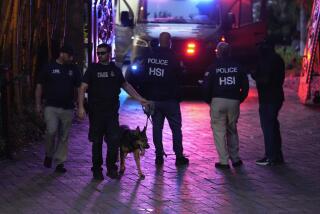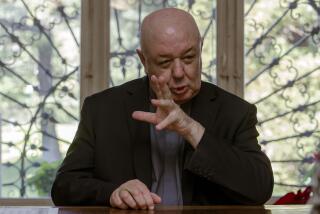Spy service files are secret no more
WASHINGTON -- Before she became a famously untidy television chef, Julia Child had a secret career as an American spy, winning praise for her attention to detail as she managed the flow of classified communications from remote posts in Ceylon and China during World War II.
Long before he appeared on screen as a lunatic general in “Dr. Strangelove” and a corrupt cop in “ The Godfather,” Sterling Hayden was parachuting into fascist Croatia as a secret operative for America’s fledgling espionage service.
And decades before he was named CIA director, William J. Casey was running clandestine operations for the agency’s predecessor -- the Office of Strategic Services, or OSS -- from its European headquarters in London.
The U.S. government pulled back the covers on these careers in espionage and thousands of others Thursday, granting public access for the first time to previously classified personnel files of Americans who served in the OSS.
The records on Child, Hayden and Casey were among 35,000 personnel files made available at a National Archives facility in suburban Washington. Archives officials said the records cover the careers of more than 24,000 OSS employees.
The documents offer new insights into the inner workings of what many consider the nation’s first formal spy service. There is still debate over whether the OSS was effective in hastening the end of the war. But the service, which was launched in 1942 and shut down three years later, accounts for one of the most colorful periods in U.S. espionage -- a time before intelligence agencies were burdened with bureaucracies or forced to answer to congressional committees.
The personnel records, many of them discolored and crumbling, are stored in a climate-controlled chamber on the archives’ second floor. Much of the material is mundane -- records of when people were hired, how much they were paid and where they were sent.
They generally do not reveal significant details about sensitive operations; much of that information is in a separate collection. But they do provide often fascinating glimpses into the backgrounds, and even personalities, of thousands of Americans who spent at least a short part of their lives working in the cloak-and-dagger world of spies.
The new documents “add a human face to the story of this organization,” said Steven Tilley, a director at the National Archives. Tilley said the documents were released in large part because of historical organizations’ pressure on the CIA, which held the files until 2001 and spent two years reviewing them before agreeing to their declassification.
“These records will certainly be of interest to researchers,” Tilley said. “They go to the personal [backgrounds] of the individuals who joined and fill in some of the gaps of what they did and how they did it.”
For example, Child -- then Julia McWilliams -- sought employment with the OSS after becoming bored with her duties as a typist for the Office of War Information. In one document she lists as her reason for leaving that organization: “typed over 10,000 little white cards and put in for a transfer to OSS.”
Child, a Pasadena native, is also disarmingly honest about other blemishes on her resume. Explaining why she had left an advertising job at a Beverly Hills department store, she wrote: “Fired, and I don’t wonder.”
She goes on to explain how she had made a tactical error that upset her supervisors and regretted that she hadn’t “been older and more experienced” so that she could have handled the situation better.
After being hired at OSS headquarters in Washington, she was sent to clandestine stations in Asia, where she was responsible for “registering, cataloguing and channeling a great volume of highly classified communications.” Child, who met her husband, Paul, in the OSS and who died in 2003, was given an award for her resourcefulness as well as her “inherent cheerfulness.”
Casey’s file is also illuminating. As director of the Central Intelligence Agency under President Reagan, he was a deeply controversial figure, credited with rebuilding the agency’s spy ranks but criticized for rogue operations and tainted by his suspected ties to the Iran-Contra scandal. His records indicate that his stint in the OSS was also marked by a penchant for risk-taking and daring operations.
In Europe, Casey developed a system for dropping operatives behind German lines during “the moonless period of the month.” His agents were so well prepared that by the time they shed their parachutes, they could blend in seamlessly with the local population, armed with cover identities that “would stand up under the closest Gestapo scrutiny.”
Among other prominent people whose OSS records were released were historian Arthur Schlesinger Jr., CIA directors Allen Dulles and Richard Helms, major league baseball catcher Morris “Moe” Berg, Supreme Court Justice Arthur J. Goldberg and millionaire philanthropist Paul Mellon (who, on his resume, listed “trustee” and “horse breeder” as prior occupations).
Of course, the vast majority of the files reflect the OSS careers of Americans whose names never achieved such recognition, and four were on hand Thursday for the opening of their own personnel files -- including Elizabeth McIntosh, 93, who followed her OSS service with a lengthy career at the CIA.
McIntosh said her time in the OSS was largely devoted to “morale operations” -- not boosting the morale of U.S. forces, she pointed out, but eroding the morale of Japanese troops. Her unit used radio broadcasts and leaflet drops to spread worry among Japanese forces.
At one point, she said, her group intercepted postcards that Japanese troops were sending home, erasing the reassuring messages the soldiers had written and replacing them with complaints about the lack of food and ammunition. Notes to sweethearts were modified to say that the soldier had met a beautiful Burmese woman and would not be coming home.
After reviewing her file, McIntosh, who lives in Woodbridge, Va., said she was thrilled to see that her supervisors had given her glowing marks. Asked whether she was comfortable seeing such information released to public view, she said, “I think it’s all right. It’s been a long time. There’s nothing to hide anymore.”
More to Read
Eat your way across L.A.
Get our weekly Tasting Notes newsletter for reviews, news and more.
You may occasionally receive promotional content from the Los Angeles Times.






